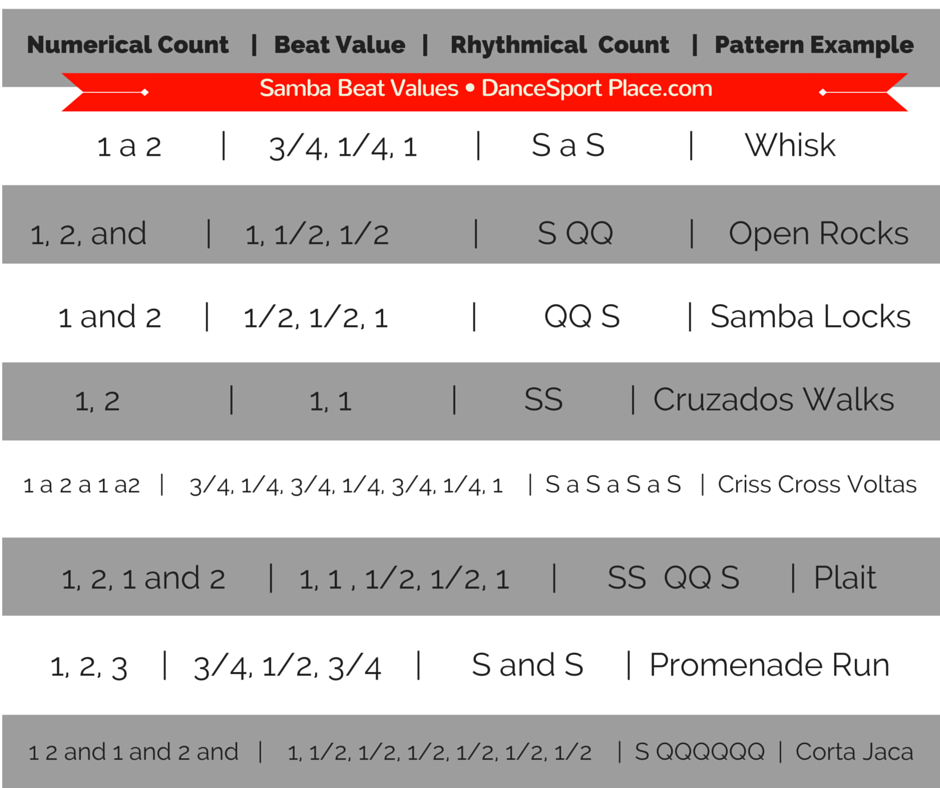Samba music is like CAFFEINE for your body.
You know how that first cuppa pops your eyes open and clears out early morning brain fog?
Well, throw on a Samba song, and your muscles automatically respond like they just got a double espresso injection: knees bouncing, chest ticking, shoulders shimmying and hips pulsating.
And it’s not only your muscles that are gettin’ down, your ears are, too. With its complex orchestration samba music allows for a large range of rhythmic interpretations.
On the one hand, having a buffet of rhythms to choose from is like having a closet full of gorgeous shoes (or ties!) to choose from–something for every occasion! On the other hand, this great variance of timings makes Samba one of the more difficult dances, from a musical standpoint.
For a quickie intro on its musical diversity, here’s our Samba 101:
Counting the Basic Rhythm: 1 a 2
Time Signature: 2/4 (2 beats per bar of music)
Accent: Strong accent on count 1, secondary accent on count 2
Samba Beat Value:

* S=Slow Q= Quick
Tempo:
Samba Pro & Amateur Pro-Am
Beats per Minute 100 96-100
Song Examples:
Vintage Samba – “A-Tisket A-Tasket” by Ella Fitzgerald
Latin Samba – “Magalenha” by Sergio Mendes
Contemporary Samba – “Whenever, Wherever” Shakira
Origins & Description:
Samba music originated in Brazil, brought about by the diversity of the musical roots of people settling in the country, including most especially the influence of the African slaves.
In the 1920’s the dance began to be noticed by Europeans and was eventually integrated into the ballroom style.
This is why Brazilian Samba dance looks much different than International Latin dance. If you’re going to Rio for Mardi Gras, you DO NOT need to learn the ballroom samba. (You DO need to get master the batucada and invest in a very skimpy, very sparkly outfit 🙂
Samba music, with it’s signature heavy drumming and full percussion, is exciting, happy and has an infectious beat that makes you want to get up and dance.
The music is characterized by a continuous pulsation, and this rhythmic undercurrent inspires the Samba Bounce action (flexing and straightening the knees), which is used in many patterns.
Note: Be careful to dance the Samba Bounce action with the beat value 1 a 2 (three quarter, quarter, whole beat) rather than 1 & 2 (half, half, whole beat) which results in a more polka-like skipping quality. The bounce action is not used in every pattern, just the ones using the “1 a 2” count.
With the complexity of the instrumentation, you can experiment with a variety of rhythms in this dance. (see the chart above ^)
Besides the musical interpretation, bring your party personality to this dance. Even though the ballroom Samba is not the Samba of the Mardi Gras, the FEELING of the dance is still a party atmosphere. Bring the FUN to the floor!
- Write your Dance: Improve your dancing through journaling - November 12, 2019
- The Difference Between Oversway and Throwaway: Ballroom Video Preview - June 8, 2018
- Principles of Movement: Ballroom Basics Video - September 21, 2016

we respect your privacy and will never share your information! Unsubscribe at any time.



